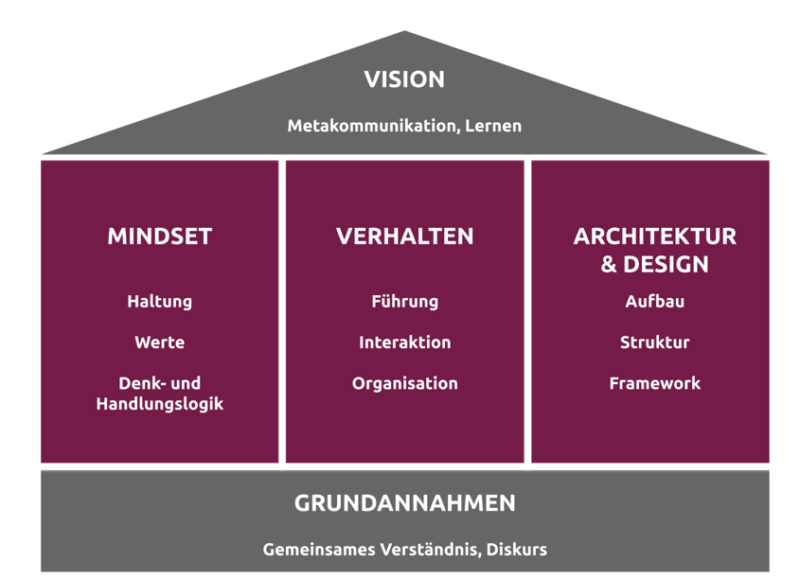Stand on the right, walk on the left. Yellow is plastic, blue is paper. Goethe's Faust, Beethoven's third. Even if we are not directly aware of it, they are all characteristics of German culture. And like the culture of a country, the culture of an organization is: it is lived, but not necessarily perceived. Agile methods can be used, but the underlying values cannot be taken into account. "Doing agile vs. being agile ". Nevertheless, culture influences the way people think and act in organizations. Peter Drucker already knew what incredibly important role the appropriate culture plays in transformations: “Culture eats strategy for breakfast.”
Doing agile vs. being agile - Companies fail because of the agile culture
There is a change in the world of work. Many companies are changing to be competitive and to be able to react actively to changes. Digitization and the world of work 4.0 are the drivers of this transformation. A particularly promising type of change is the transformation towards an agile organization: Agility promises higher productivity and increased employee engagement. This in turn has a positive impact on the growth of the company and its success.
Dedicated employees and company growth & #8211; no top management says no. But it's not that easy with agile change. Survey show that although a majority of large companies are currently in a transformation process, 19% have already failed because of this. One or the other managing director wonders: Why is it that the KPIs do not change even though we have introduced agile frameworks?
The State of Agile Report shows very clearly why. Agile change means change in corporate culture. The mere introduction of new methods, such as Scrum, is not enough to work successfully agile. A corporate culture that is not in line with the agile manifesto is the biggest reason why agile projects fail.
Doing agile vs. being agile and the aGreat culture - what does that mean?
The culture of a company is shaped by people. Through individuals and through relationships between these individuals. Generally speaking, you can use the mindset compare at the organizational level. If this mindset is not “agile”, then no agile change can take place. Various factors contribute to this mindset at the organizational level. The most important are the culture of trust between the management level and the employees, the management styles and the development of the employees. The structure of the organization forms the framework for the whole.
You can also visualize cultural change as a house present (Hofer & Thonet, 2019). There are three pillars on a foundation of shared basic assumptions: mindset, behavior and architecture & design. Change must be driven forward in all three so that a common vision, which is the roof, can arise.

Successfully create an agile culture
Since culture depends on people, it is also the starting point for cultural change. First of all, the context must of course be a breeding ground for the agile mindset. In this context, context means the structure of the company. Employees should feel close to the management level & #8211; management should not be the unattainable decision-making power. Agile companies often operate in a network structure that is characterized by leanness and short decision-making processes.
So you should change the situation first. It quickly becomes clear that the changed situation is a prerequisite for changes in the mindset. The mindset is often blamed for failed transformations & #8211; but a mindset cannot develop if the context does not allow it. If we put the blame on the mindset, we are subject to it fundamental attribution error.
An agile corporate structure requires a new one Managers' self-image, They should be “enablers”, that is, enable employees to work successfully and to develop. In this role, it is beneficial if they agile tools use. The executives can do it tranformational leading and conveying a vision inspire your employees.
Inspired employees are more likely to see why and how they can develop. The development of one is fundamental Growth Mindse - see article on this, If they are encouraged to view their work as a learning process, the way they deal with challenges and changes changes.
Doing agile vs being agile - start with agile methods
Once these cornerstones have been laid, agile frameworks can be introduced. Of course, this does not have to be a successive process - it is also possible to introduce the frameworks in parallel with cultural change. Actually it shouldn't be called “Doing agile vs being agile”, but “Doing agile gets you to being agile”.
The work of self-organized teams, for example with Scrum, allows companies to react much faster to changing requirements and, accordingly, to be successful in a changing environment. However, concentrating on the introduction of these methods or frameworks without having to worry about the employees beforehand can lead to failure of the change. So get in touch with your employees & #8211; What is it about? What do you need? Do you feel ready to work with agile methods?
Think carefully about how you can make it clear to them: what's in them for them?
Very important: do not lose faith. There are enough examples that it is possible to fundamentally change the corporate culture!
To really come to being agile, retrospectives are probably one of the most important events. You can serve the agile values to reflect. And on Agile Mindset of the employee. This is exactly why we developed our retrospective tool - directly from the psychological faculty of the University of Münster. More information can be found below 🙂
You want to go from doing agile to being agile? Reflect on the agile values and apply them to the mindset? This is exactly why we developed our retrospective tool. More information here:









